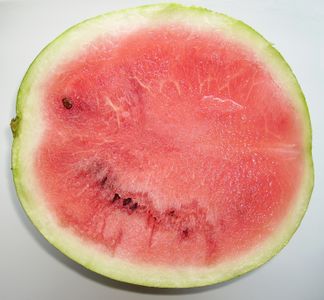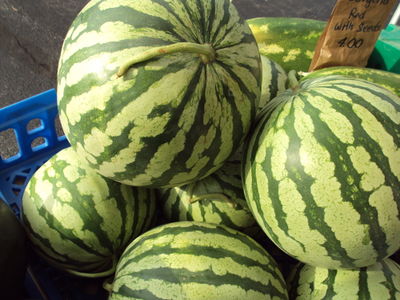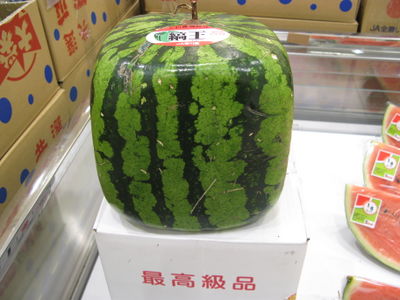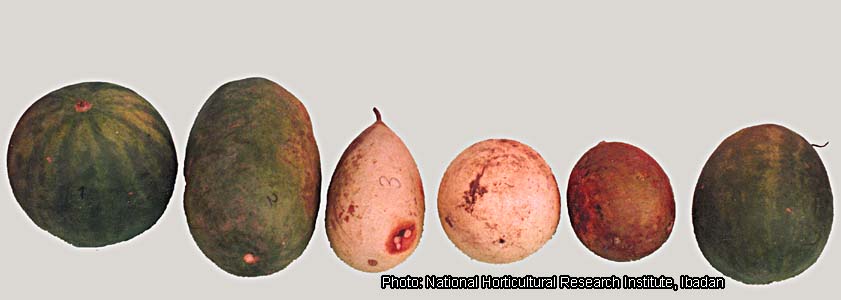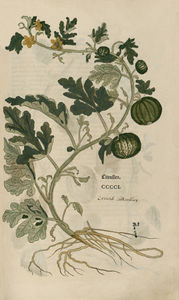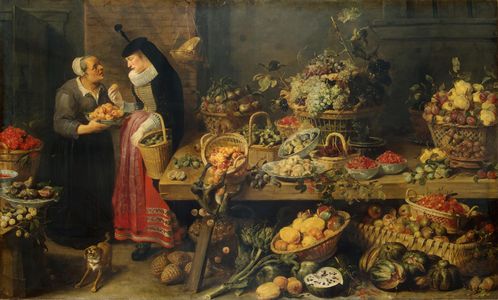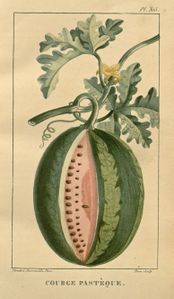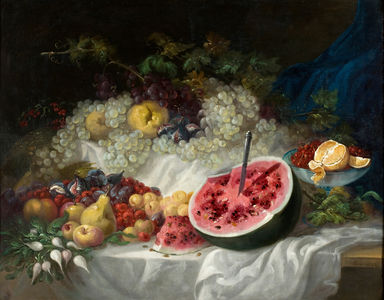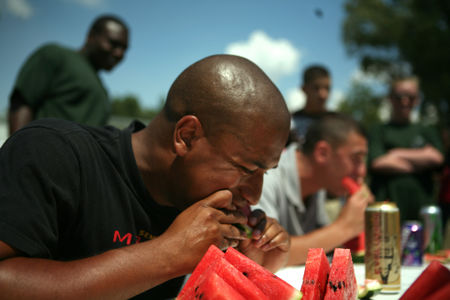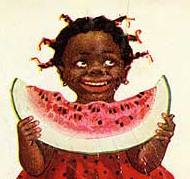Citrullus lanatus
Citrullus lanatus
(Thunb.) Matsum. & Nakai
| Ordre | Cucurbitales |
|---|---|
| Famille | Cucurbitaceae |
| Genre | Citrullus |
2n = 22
Origine : Afrique australe
sauvage et cultivé
| Français | pastèque |
|---|---|
| Anglais | watermelon |
- fruit rouge ou jaune mangé comme dessert, parfois cuit
- le fruit donne une eau saine (tant qu'il n'est pas ouvert)
- écorce du fruit confite au vinaigre ou au sucre
- graines consommées réduites en pâte et donnant une huile alimentaire
- graines pour faire du savon
- graines succédané du café
- graines et fruits médicinaux
- feuilles parfois consommées comme légume
- feuilles et fruits comme fourrage et source d'eau pour le bétail
Sommaire
Description
- plante herbacée annuelle, monoïque ou parfois andromonoïque, à longues tiges pubescentes
- vrilles bifides
- feuille obovale palmatilobée à lobes profonds pennatilobés
- fleurs jaune soufre
- fruit rond, oblong ou cylindrique, glabre à maturité, à écorce épaisse, sans cavité centrale
- graines de grosse taille (5 à 15 mm de long) noyées dans la chair
Noms populaires
| français | pastèque |
| anglais | watermelon |
| allemand | Wassermelone |
| néerlandais | watermeloen |
| espagnol | sandía ; patilla (Venezuela) |
| portugais | melancia, pateca |
| italien | cocomero, anguria, melone d'acqua |
| arabe | بطيخ - baṭṭīẖ, dillā‘ |
| russe | arbuz |
| turc | karpuz, kavun |
| persan | kharbūza |
| hindi | tarbūz, tarbūzā |
| chinois | xī guā ; tay kwa |
- Voir les noms de la Flore populaire d'Eugène Rolland
Classification
Citrullus lanatus (Thunb.) Matsum. & Nakai (1916), nom. cons.
basionyme : Momordica lanata Thunb. (1794). La plante récoltée par Thunberg est du Groupe Citre.
synonymes :
- Cucurbita citrullus L. (1753)
- Citrullus vulgaris Schrad. (1836)
- Citrullus battich Forssk. (1775)
- Colocynthis citrullus (L.) Kuntze (1891)
On distingue quatre groupes de cultivars.
Groupe Pastèque
Dessert Group
synonyme : subsp. vulgaris (Schrad.) Fursa (1972)
C'est la pastèque proprement dite, à haute teneur en eau, et de couleur rouge vif ou jaune.
Groupe Citre
Citroides Group
synonymes :
- Citrullus vulgaris Schrad. var. citroides L. H. Bailey (1930)
- Citrullus lanatus var. citroides (L.H. Bailey) Mansf. (1959)
- Citrullus amarus Schrad. (1836)
- Citrullus caffer Schrad. (1838)
- français : citre, méréville, melon d'eau, gigérine, barbarine, pastèque fourragère
- anglais : citron, cooking melon, fodder melon, preserving melon
Fruit arrondi, à chair blancâtre et graines souvent rouges. Ce type est cultivé en Russie et en Asie centrale pour l'alimentation du bétail. En Europe, il est cultivé ça et là dans les jardins pour faire des confitures. En France, on le trouve dans de nombreuses régions, mais sous des noms différents.
Groupe Egusi
Mucosospermus Group
synonyme :
- subsp. mucosospermus Fursa (1972)
- Citrullus mucosospermus (Fursa) Fursa (1983)
- français : pastèque égousi
- anglais : egusi watermelon
- Voir toutes les espèces appelées egusi.
Cultivé en Afrique de l'Ouest pour ses graines oléagineuses, à l'instar de Melothria sphaerocarpa avec qui elle partage le nom d'égousi. Des formes sauvages sont connues du Bénin et du Ghana. La chair est molle, peu amère et rosée au centre.
Groupe Cordophanus
Cordophanus Group
synonyme : subsp. cordophanus Ter-Avan. (1966)
- français : melon tsama
- anglais : tsama melon
Type plus ou moins sauvage ou semi-cultivé, mal défini, présent dans les zones arides du sud et de l'est de l'Afrique. C'est l'ancêtre direct de la pastèque.
Cultivars
Histoire
Culture
Aux Etats-Unis, un cliché raciste veut que les Noirs sont supposés avoir un amour immodéré pour la pastèque. Ils ne sont apparemment pas les seuls.
Usages
- lanatus : Includes wild plants of the Kalahari (tsamma, also recently taken into cultivation) and one cultivar group. The fruits of wild plants are an important source of water for humans and animals; the leaves, young fruits and seeds are also used as vegetables.
- Dessert Group : Long cultivated, now grown in almost all the warmer areas of the world (in the CIS republics and in North America to 50o N, and one of the most valuable fruit crops in both areas). Chiefly eaten raw as a dessert fruit. In the orient, often converted into "nardek" (watermelon honey). In Russia, the fruit is also salted like cucumbers. Spoilt fruit makes a good fodder for cattle. The seeds yield a good edible oil or are eaten roasted. The plant has good drought resistance. Although there are numerous cultivars, the fruit is much less diverse in form and flavour than that of the melon (Cucumis melo). The history of the cultivated watermelon is as yet little investigated. Formerly it was hypothesized that the species was once naturally distributed in the wild as for north as Egypt and the Near East, and there domesticated, since there was no ancient agriculture in South Africa; but there is no evidence that other than feral forms have ever occurred in the wild outside the Kalahari area, and clearly the tsamma watermelon is the ancestral form of the dessert watermelon. Comparative isozyme studies are required, to compare wild plants and primitive African landraces with the cultivated forms of Asia, Europe and North America. Fursa in Fursa & Filov (1982) recognizes 31 cultivar types, based on fruit form and colour, and in parallel to these, 10 ecological-geographical groups. In Japan, seedless triploid cultivars with high quality fruits (seedless watermelons) have been developed, now widely grown in the USA and elsewhere.
- Cordophanus Group : A rather ill-defined group of cultivated and semicultivated forms in the Sahara, the Sudan, upper Egypt and N Kenya. Some of the Saharan landraces appear to be perennial and may be products of introgression from C. colocynthis. Both bitter and non-bitter forms are known.
- Mucosospermus Group : Cultivated in W Africa (e.g., Senegal, Mali, Guinea, Ghana, Niger, Nigeria). Forms with large, soft-coated seeds, rich in oil and protein, which are valued as a protein source. They are used as a masticatory, and for oil production. The best quality oil is also used in cooking. Each territory has its own special cultivars. The plants are said to have a rather high resistance to mildew.
- Citroides Group : Primitive forms in South Africa; cultivated in the USA (many cultivars) and in the south of the CIS republics (also cultivars). In the Near East, Asia Minor and S Russia, also found as a weed in melon fields. The fruits are used as cattle fodder, less often for the preparation of citron peel or for the production of pectin.
Références
- Andrews, A.C., 1956. Melons and watermelons in the classical era. Osiris, 12 : 368-375.
- Blake Leonard W., 1981. Early acceptance of watermelon by Indians of the United States. J. Ethnobiol., 1(2) : 193-199.
- Chauvet, Michel, 2018. Encyclopédie des plantes alimentaires. Paris, Belin. 880 p. (p. 208)
- Chomicki, G. & Renner, S. S., 2015. Watermelon origin solved with molecular phylogenetics including Linnaean material: another example of museonomics. New Phytol., 205 : 526-532. doi : 10.1111/nph.13163
- Dane, F. & J. Liu. 2007. Diversity and origin of cultivated and citron type watermelon (Citrullus lanatus). Genet. Resources Crop Evol., 54: 1255–1265.
- Dubler, C.E., 1943. Temas geográficos-lingüísticos. II: Badea-Sandía. Al-Andalus, 8 : 383-413.
- Jacquin M., 1832. Monographie complète du melon, contenant la culture, la description et le classement de toutes les variétés de cette espèce, suivies de celles de la pastèque à chair fondante avec la figure de chacune dessinée et colorée d'après nature. Paris, Rousselon. 199 p., 33 pl. h.t.
- Knight, M.H., 1995. Tsama melons, Citrullus lanatus, a supplementary water supply for wildlife in the southern Kalahari. African Journal of Ecology, 33 (1): 71–80.
- Lawrence, Anna, Camilo Uribe Botta, & May Wang, 2021. Watermelon: Stereotypes of Race and Class. Dumbarton Oaks. Plant Humanities
- Pangalo, K.I., 1930. [Water-melons of the northern hemisphere]. Bjul. prikl. Bot., 23 (3) : 41-84.
- Levi, Amnon et al., 2016. Genetic Resources of Watermelon. In: Grumet, R., Katzir, N., & Garcia-Mas, J., (eds). Genetics and Genomics of Cucurbitaceae. Plant Genetics and Genomics: Crops and Models, vol 20. Springer. 87-110. doi : 10.1007/7397_2016_34
- Lost Crops of Africa. Volume II: Vegetables, 2006. Washington, National Academies Press. 354 p. en ligne (egusi)
- Lost Crops of Africa. Volume III: Fruits, 2008. Washington, National Academies Press. 380 p. en ligne
- Nesom, G. L., 2011. Toward consistency of taxonomic rank in wild/domesticated Cucurbitaceae. Phytoneuron, 13 : 1-33. en ligne à Phytoneuron, télécharger le pdf
- Paris, H. S. 2015. Origin and emergence of the sweet dessert watermelon, Citrullus lanatus. Ann. Bot. (Oxford), 116 : 133-148.
- Renner, S. S. et al. 2014. (2313) Proposal to conserve the name Momordica lanata (Citrullus lanatus) (watermelon, Cucurbitaceae), with a conserved type, against Citrullus battich. Taxon, 63: 941-942. doi : 10.12705/634.29
- Renner, S. S. et al., 2019. A 3500-year-old leaf from a Pharaonic tomb reveals that New Kingdom Egyptians were cultivating domesticated watermelon. bioRxiv, 642785
- Yong, Xu & Guo, Shaogui, 2016. The Watermelon Genome. In: Grumet, R., Katzir, N., & Garcia-Mas, J., (eds). Genetics and Genomics of Cucurbitaceae. Plant Genetics and Genomics: Crops and Models, vol 20. Springer. 199-210. doi : 10.1007/7397_2016_22
Liens
- BD des Plantes d'Afrique
- BHL
- FAO Ecocrop
- Feedipedia
- Flora of China
- Grieve's herbal
- GRIN
- IPNI
- Lost Crops of Africa
- Lost Crops of Africa (egusi)
- Mansfeld
- Moerman, Native American Ethnobotany
- Multilingual Plant Name Database
- NewCrop Purdue
- Plant List
- Plants for a future
- Plants of the World Online
- PROSEA sur Pl@ntUse
- PROTA sur Pl@ntUse
- TAXREF
- Tela Botanica
- Useful Tropical Plants Database
- Wikipédia
- World Flora Online





